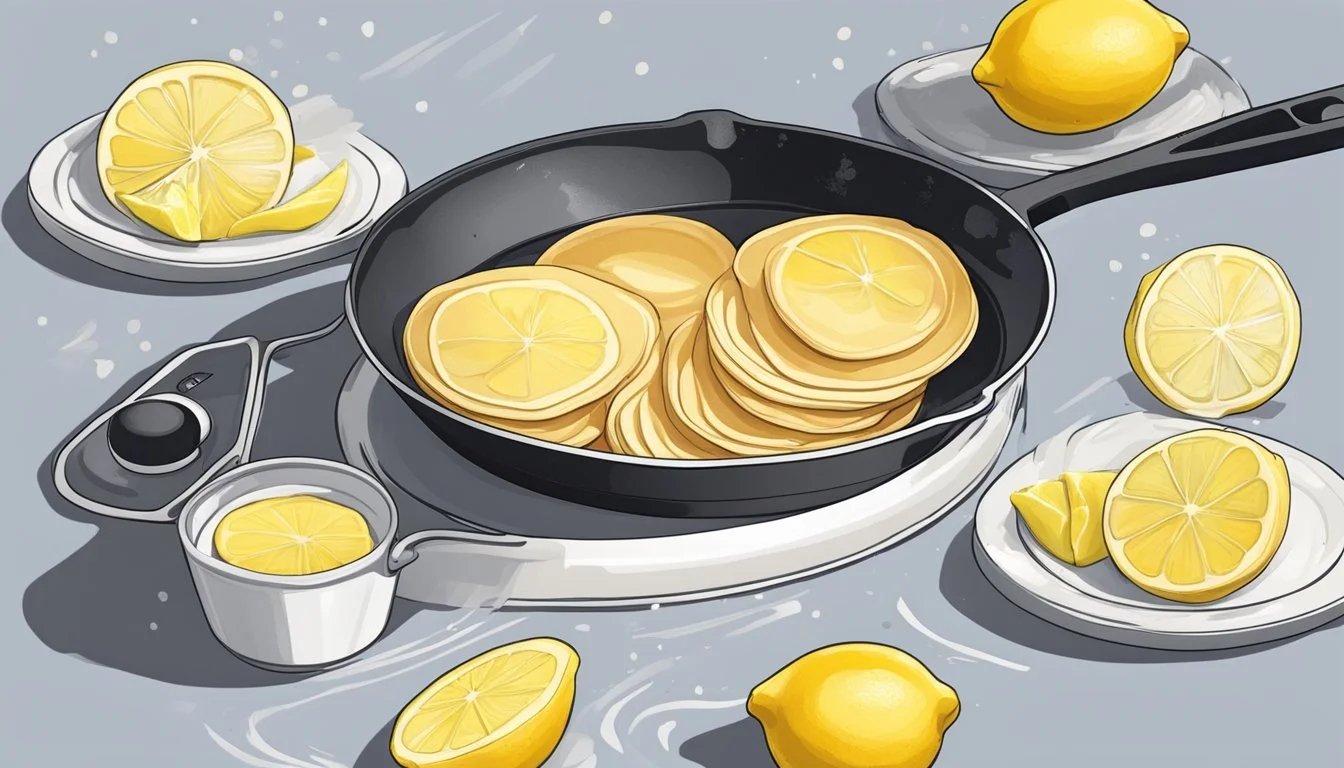Best Way to Reheat Lemon Ricotta Pancakes
Secrets to Maintaining Fluffiness and Moisture
Lemon ricotta pancakes are a delightful twist on the traditional breakfast favorite, offering a zesty and creamy flavor that sets them apart. The unique combination of lemon and ricotta not only adds depth to the taste but also contributes to the tenderness of the pancakes. However, maintaining that same fluffiness and moisture when reheating leftovers is crucial for enjoying them as if they were freshly made.
The best way to reheat lemon ricotta pancakes involves gentle heat and a method that preserves their moist interior, while also reviving the exterior to a lightly crisp texture reminiscent of their initial cook. Oven reheating is recommended as it evenly warms the pancakes and keeps them fluffy. It's essential to preheat the oven and arrange the pancakes in a single layer on a non-stick baking sheet, avoiding overlap which can lead to uneven heating.
While moistness is key, preventing the pancakes from becoming soggy is equally important. Covering them with foil during the reheating process helps to retain moisture without compromising the texture. The result should be lemon ricotta pancakes that are warmed through and retain the delicate crumb and creamy flavor that they are known for.
Overview of Lemon Ricotta Pancakes
Lemon Ricotta Pancakes are a sophisticated twist on traditional pancakes, incorporating the brightness of lemon and the richness of ricotta cheese. The key ingredients that set these pancakes apart are lemon zest and ricotta cheese, providing a unique flavor and texture. Typically, the recipe involves a simple batter that's enhanced with the zest of lemons for a citrusy zing and fresh ricotta cheese to achieve a creamy and moist consistency.
They are a favorite in both Italian-inspired cuisine and as a gourmet option in breakfast recipes across various culinary traditions. The batter is often left slightly lumpy, which ensures that the pancakes stay fluffy after cooking. It's common to serve these pancakes with fresh berries, enhancing their fresh and light taste profile.
Ingredient Role in Pancakes Lemon zest Imparts a citrus flavor Ricotta cheese Adds creaminess Fresh berries Serve as a tangy topping
When preparing Lemon Ricotta Pancakes, chefs usually recommend folding the wet ingredients into the dry ones until just combined. Overmixing is avoided to maintain the pancakes' lightness. These pancakes stand as a testament to the delightful union of lemon and ricotta — a duo that brings a delicate, yet distinct, dimension to this beloved dish.
Preparing Your Pancakes for Reheating
Proper preparation of lemon ricotta pancakes for reheating begins immediately after they are cooked. Ensuring pancakes are cooled and stored correctly will maintain their fluffiness and moisture when it comes time to reheat them.
Cooling and Storing Pancakes Properly
After cooking lemon ricotta pancakes, one should let them cool to room temperature before the storing process. This prevents condensation inside the storage container which can lead to sogginess. Once cooled, the pancakes should be placed in an airtight container or wrapped securely to protect them from absorbing odors and moisture. If pancakes are to be eaten within a day or two, storing them in the refrigerator is suitable.
Cooling Steps:
Lay pancakes out in a single layer on a cooling rack.
Allow to cool completely to room temperature.
Storing Steps in Refrigerator:
Transfer to an airtight container.
Separate layers with parchment paper to prevent sticking.
Freezing Pancakes the Right Way
For longer storage, freezing pancakes is the best option to preserve their freshness. To freeze pancakes, individual pancakes should be laid out on a baking sheet and placed in the freezer until solid. This prevents them from sticking together. Once frozen, the pancakes can be transferred into a freezer-safe bag or container. Properly packed frozen pancakes can last up to three months.
Freezing Steps:
Arrange pancakes in a single layer on a baking sheet.
Freeze until each pancake is firm.
Place frozen pancakes into a freezer-safe bag, removing as much air as possible.
By following these steps, leftover pancakes will be well-preserved for reheating, ensuring they retain their desirable fluffy texture and moistness inherent to lemon ricotta pancakes.
Reheating Techniques Explained
When reheating lemon ricotta pancakes, maintaining their fluffy texture and moisture is crucial. Each technique comes with different advantages depending on the equipment available and desired outcome.
Using the Oven for Even Warmth
The oven is effective for heating pancakes evenly and preserving their fluffy texture. To reheat lemon ricotta pancakes in the oven:
Preheat to 350°F (180°C).
Place pancakes on a baking sheet with a half-inch of space between each.
For extra moisture, lightly brush with melted butter, though this is optional.
Cover with foil to lock in moisture and heat for 5-10 minutes.
Microwave Reheating for Quick Results
Microwaving offers the fastest route to warm pancakes, though it might slightly affect texture. For microwaving:
Reheat in 20-second bursts.
Use a microwave-safe plate and cover the pancakes with a damp paper towel to promote moisture retention.
Check the pancakes after each burst to ensure they're not overheating.
The Toaster Method for Crisp Edges
The toaster or toaster oven provides a quick way to add a crisp edge to the pancakes while warming them. To use a toaster:
Set the toaster to a medium setting.
Place pancakes directly into the toaster slots or on the toaster oven rack.
Monitor closely to prevent burning and heat for about 1 minute.
Skillet Warming for a Freshly Made Feel
Reheating pancakes on a skillet mimics the original cooking method and can help retain their fresh taste. Use a non-stick skillet on the stove:
Warm the skillet over medium-low heat.
Lightly butter or oil the skillet to prevent sticking and add savory notes.
Transfer pancakes to the skillet and heat for 1-2 minutes on each side.
Restoring Fluffiness and Moisture
When reheating lemon ricotta pancakes, one must carefully manage heat and time, as well as use moisture-retentive covering techniques. These ensure pancakes stay fluffy and moist, as they were when first served.
Managing Heat and Time
Temperature is crucial for reheating while preserving the pancakes' fluffiness. The oven should be preheated to 350 degrees Fahrenheit, a moderate temperature that helps the pancakes warm uniformly without becoming dry or tough. Reheating should be limited to 5 to 10 minutes; this range of time allows the pancakes to become thoroughly warm without losing their texture.
Heat distribution: Ensure pancakes are in a single layer on a baking sheet.
Spacing: Keep them separated by at least 1/2 inch to allow for even heat circulation.
Care should be taken not to overheat, as this can cause pancakes to become firm rather than soft and fluffy.
Covering Techniques to Retain Moisture
To retain the moisture within lemon ricotta pancakes, one should cover them with aluminum foil during the reheating process. This method traps steam, which prevents the pancakes from drying out and helps them to remain moist.
Foil: Tight covering with foil locks in moisture; lightly tent to avoid sticking to pancakes’ surface.
Rest: Allow pancakes to rest for a few minutes after reheating under the foil before serving. Resting helps redistribute moisture and maintain the pancakes’ internal structure.
Moisture can also be aided by using a paper towel:
Drape a lightly dampened paper towel over the pancakes before covering with foil. The water from the paper towel turns to steam, creating a humid environment that helps the batter's bubbles stay intact and encourages pancakes to rise slightly upon reheating.
Enhancing Flavor and Texture After Reheating
Reheating lemon ricotta pancakes properly can greatly affect their texture and flavor. By considering the addition of complementary toppings and the judicious use of butters and syrups, one can elevate the pancakes beyond their initial delight.
Creative Toppings and Add-Ins
The selection of toppings can significantly influence both the flavor and texture of reheated lemon ricotta pancakes. Fresh fruit such as blueberries and strawberries introduce a juicy contrast that complements the lemon's tartness. For added crunch and sweetness, sprinkle granulated sugar which can create a light caramelization upon contact with the warm pancake surface. Incorporating chocolate chips into the batter before reheating, or as a topping afterwards, can add a satisfying melt-in-your-mouth quality. Using lemon curd and whipped cream as a duo allows for a silky, creamy finish that enhances the ricotta's subtle richness.
Topping Ideas:
Blueberries and strawberries for a fruity zest.
A sprinkle of cinnamon or chocolate chips for a flavor twist.
Lemon curd and whipped cream for creaminess.
Proper Use of Butters and Syrups
To preserve the pancakes' desired fluffiness, it is essential to apply butter and maple syrup cautiously. Melting butter should be brushed or drizzled on the pancakes to keep them moist without being soggy. A tactful drizzle of warm maple syrup can penetrate the pancakes, enhancing their inherent sweetness, while maintaining their texture. To ensure the pancakes are not overpoweringly sweet, consider a light-handed approach with these additions.
Syrup Application:
Use a warm maple syrup drizzle.
Apply melted butter sparingly.
By being mindful of these enhancements, the pancakes will tantalizingly retain their fluffy texture and rich, lemony freshness upon reheating.
Pancake Recipe Variations and Tips
When customizing the classic lemon ricotta pancake recipe, cooks should consider the role of each ingredient to maintain the balance between fluffiness and moisture. Below are variations and tips to enhance your pancake experience.
Flour: All-purpose flour is typically used for a reliable structure, but for a lighter pancake, one could substitute half with cake flour.
Leavening Agent: Baking powder is crucial. For extra rise, ensure it's no more than 6 months old.
Protein: Adding an extra egg can enrich the batter. One may separate the yolks and whites, beating the whites to soft peaks before folding into the batter for added fluffiness.
Dairy: Substitute buttermilk for milk to introduce a tangy flavor and tender crumb, due to its acidity.
Sweetness: Adjust sugar to taste, but be mindful that it contributes to browning and texture.
Flavoring: Pure vanilla extract enhances depth; lemon zest boosts freshness.
Salt: A pinch of salt balances flavors. Do not omit.
When adjusting the recipe, changes should be made incrementally, and one should note how each affects the final pancake. For instance, more protein (i.e., adding an egg) offers structure but can make pancakes tough if overmixed. It's key to combine wet and dry ingredients until just incorporated to keep them tender.
Tips for a Better Batter:
Mix: Gently; overmixing leads to dense pancakes.
Rest: Let the batter sit for a few minutes to allow the flour to hydrate and the baking powder to activate.
Cook: On medium heat to balance cooking through and surface browning.
These tips and variations allow cooks to tailor lemon ricotta pancakes to their preferences while maintaining the beloved fluffy and moist texture.
Precautions and Common Mistakes to Avoid
When reheating Lemon Ricotta Pancakes, maintaining their original fluffy and moist texture is important. One must follow proper instructions and be mindful of the heating technique used.
Not Overcrowding the Heating Surface
To prevent the pancakes from steaming and becoming soggy, they should be spaced out. On a skillet or in an oven, pancakes need room for air circulation. Here's how one can arrange them:
Skillet: Place pancakes in a single layer with some space between each.
Oven: Arrange pancakes on a baking sheet with at least 1/2 inch separation.
Ensuring that pancakes do not overlap helps to achieve an even golden brown color and retains their airy texture.
Avoiding Excessive Heat
High temperatures can dry out pancakes, so gentle reheating is key. One should avoid setting the heat too high; a moderate temperature will warm the pancakes through without sacrificing texture. Use the following settings as a guide:
In an oven, preheat to no higher than 350 degrees Fahrenheit.
On a skillet, keep the heat to a medium to low setting.
Allow the pancakes to heat until they are just warm to the touch, which ensures they stay moist and fluffy.
Conclusion: Ensuring the Perfect Reheat Every Time
Reheating lemon ricotta pancakes to maintain their delightful fluffiness and moistness is a task that benefits from a knowledgeable approach. The key to success lies in gentle reheating that prevents the pancakes from becoming overly dry or tough, thereby retaining their original texture and flavor.
Oven Method:
Preheat the oven to 350°F.
Place pancakes in a single layer on a baking sheet.
Optionally, a light brush of butter can be applied for added richness.
Cover with foil to lock in moisture.
Reheat for 5 to 10 minutes, depending on the quantity.
Microwave Method:
Use a lower power setting to avoid rubbery textures.
Heat a single pancake for 20 seconds, adding 10 seconds per additional pancake.
Skillet Method:
Warm a non-stick skillet over medium heat.
Reheat pancakes for 1 minute on each side or until just heated through.
Air Fryer Method:
Set the air fryer to 350°F.
Arrange pancakes in a single layer.
Heat for 2 to 3 minutes for a slightly crisp exterior.
A simplistic approach underscores that lemon ricotta pancakes, when reheated properly, will retain their fluffiness and distinctive taste. They consistently demonstrate that the best methods require minimal ingredients and focus on temperature control and timing. This reinforces confidence in the ability to easily recreate the satisfying experience of freshly made lemon ricotta pancakes.






